Development of an Innovative Non-Destructive and Field-Oriented Method to Quantify the Bond Quality of Composite Strengthening Systems on Concrete Structures
Abstract
1. Introduction
2. Description of the NDT Method
3. Experimental Program
3.1. Experimental Setup
3.1.1. ND Pull-Off Test Setup
3.1.2. Optical Fiber Sensing Setup
3.2. Specimen
3.3. Loading Procedure
4. Finite Element Modelling of the Test
5. Results and Discussions
5.1. Load vs. Displacement Curve and Bond Stiffness
5.2. Uncertainty Analysis and Performance of the Test Method
5.2.1. Estimation of Sensitive Parameters
5.2.2. Reference Bond Stiffness
5.2.3. Experimental Uncertainties
- (1)
- Measurement uncertainties due to the load and displacement sensors,
- (2)
- Errors arising from the postprocessing of the load vs. displacement data (square fit of uncertain data),
- (3)
- Repeatability and reproducibility errors, which were evaluated by performing additional tests.
5.2.4. Performance of the Test Method: Minimal Detectable Value of the Adhesive E-Modulus
- (1)
- With a 67% confidence level for a variation of 0.23 × 109 N/m
- (2)
- With a 99% confidence level for a variation of 0.46 × 109 N/m
5.3. Determination of the Limit Load for the ND Test
5.4. Recommended Testing Procedure for on-Site Inspection
- (1)
- Small, strengthened test panels (about 200 mm × 200 mm) should be bonded next to the strengthening system to be monitored at the time of installation T0. The total amount of test panels should be planned in relation to the target number of monitoring terms;
- (2)
- Multiple displacement sensors should be used and disposed (i.e., attached to the dolly) consistently with the symmetry of the system, so the displacement data can be averaged;
- (3)
- At each term, a series of tests should be performed until failure on the dedicated test panels in order to assess the limit load for the ND pull-off test. An 80% rate of the minimal failure load is recommended;
- (4)
- At each term, additional small test panels should be installed using the reference adhesive system. Special care should be given to find a location of similar concrete conditions. The reference panels should be cured under optimal conditions. The ND pull-off test on these panels provides the reference bond stiffness K0;
- (5)
- The ND pull-off test should be performed on the monitored strengthening system to assess its bond stiffness for the current term;
- (6)
- Using the methodology based on the calibrated FEM followed in paragraph 5.2, the change in bond stiffness which can be inferred with a high confidence to a degradation of the E-modulus can be announced. If the bond stiffness K of the monitored system appears to be lower than this critical change, the associated E-modulus of the adhesive should be traced back with the numerical model.
5.5. Results of the Optical Fiber Strain Measurements
6. Conclusions and Outlooks
- (1)
- The load vs. displacement response of the joint appears to hold information about the E-modulus of the adhesive layer between the composite plate and the concrete surface, which in turn is related to the bond quality of the system;
- (2)
- The results of the test method appear to be most relevant when compared to a reference system tested under the same conditions;
- (3)
- The performance of the test method is expressed in terms of a minimal detectable E-modulus of the adhesive layer, given the E-modulus of the reference system (in other words, in terms of a minimal detectable change in E-modulus). For a reference E-modulus of 11.2 GPa, a degradation down to 4.0 GPa will be detected with a 67% confidence level, and down to 2.2 GPa with a 95% confidence level;
- (4)
- The loading conditions are very similar to those of the standard destructive pull-off test, and the specimens exhibit a brittle behavior when tested until failure. Hence, it can be considered performing the ND test up to 80% of the failure load;
- (5)
- The test method could be easily adapted for field inspection as it is designed with the same loading ball-joint fixture as a commercial pull-off tester;
- (6)
- The suggested measurement chain consists of load measurements synchronized with two high accuracy and long range optical digital sensors collecting the differential displacements between the test dolly bonded to the composite surface and the concrete surface. It is perfectly suitable for the purpose of the test and could be easily transferred in the field, provided that the load cell of the commercial pull-off tester is accurate enough;
- (7)
- Averaging multiple displacement measurements appears to be relevant to offset alignment or horizontality defects;
- (8)
- Additional distributed strain measurements by means of DOFS embedded in the adhesive layer provide useful information to understand the behavior of the system under pull-off loading. It also happens to be a promising alternative approach to quantify the bond quality as the strain profiles depend on the E-modulus of the adhesive.
- The E-modulus of the concrete material highly impacts the bond stiffness of the joint and its influence should be carefully assessed and quantified. It could be interesting to address whether an ND pull-off test on the bare concrete surface could provide a background value to normalize the test results;
- The ageing behavior of the adhesive joint should be monitored with the proposed test method in the context of an experimental durability program in order to assess the performance of the test method with an environmentally degraded E-modulus. Note that the failure load of the system is expected to decrease during ageing, while the system response might exhibit a more ductile behavior. Hence, the limit load that should not be exceeded during the ND test is expected to decrease at each inspection term. This will reduce the set of data available for the determination of the bond stiffness;
- The field application should be broader to encompass other usual practical cases, in particular systems strengthened by wet lay-up processes and/or with multiple composite layers.
Author Contributions
Funding
Conflicts of Interest
References
- Cascardi, A.; Leone, M.; Aiello, M.A. Transversal joining of multi-leaf masonry through different types of connector: Experimental and theoretical investigation. Constr. Build. Mater. 2020, 265, 120733. [Google Scholar] [CrossRef]
- Hai, N.D.; Mutsuyoshi, H.; Asamoto, S.; Matsui, T. Structural behavior of hybrid FRP composite I-beam. Constr. Build. Mater. 2010, 24, 956–969. [Google Scholar] [CrossRef]
- Drosopoulos, G.A.; Stavroulakis, G.E.; Massalas, C.V. FRP reinforcement of stone arch bridges: Unilateral contact models and limit analysis. Compos. Part B 2007, 38, 144–151. [Google Scholar] [CrossRef]
- Sansalone, M.; Street, W. The impact-echo method. NDT.net 1998, 3, 3–5. [Google Scholar]
- Ribolla, E.L.M.; Hajidehi, M.R.; Scimemi, G.F.; Spada, A.; Giambanco, G. Assessment of bonding defects in FRP reinforced structures via ultrasonic technique. Chall. J. Struct. Mech. 2016, 2, 139–146. [Google Scholar]
- Sun, R.; Sevillano, E.; Perera, R. Debonding detection of FRP strengthened concrete beams by using impedance measurements and an ensemble PSO adaptive spectral model. Compos. Struct. 2015, 125, 374–387. [Google Scholar] [CrossRef]
- Gholizadeh, S. A review of non-destructive testing methods of composite materials. Procedia Struct. Integr. 2016, 1, 50–57. [Google Scholar] [CrossRef]
- Taillade, F.; Quiertant, M.; Benzarti, K.; Aubagnac, C. Shearography and pulsed stimulated infrared thermography applied to a ND evaluation of FRP strengthening systems bonded on concrete structures. Constr. Build. Mater. 2011, 25, 568–574. [Google Scholar] [CrossRef]
- Qiu, Q.; Lau, D. Use of laser reflection technique for defect detection in CFRP concrete systems. In Proceedings of the Nondestructive Characterization and Monitoring of Advanced Materials, Aerospace, and Civil Infrastructure, Las Vegas, NV, USA, 21–24 March 2016. [Google Scholar]
- Taillade, F.; Quiertant, M.; Benzarti, K.; Aubagnac, C.; Moser, E. Shearography applied to the non destructive evaluation of bonded interfaces between concrete and CFRP overlays: From the laboratory to the field. Eur. J. Environ. Civ. Eng. 2011, 15, 545–556. [Google Scholar] [CrossRef]
- Qiu, Q. Imaging techniques for defect detection of fiber reinforced polymer-bonded civil infrastructures. Struct. Control. Health Monit. 2020, 27, e2555. [Google Scholar] [CrossRef]
- Chataigner, S.; Caron, J.F.; Benzarti, K.; Quiertant, M.; Aubagnac, C. Use of a single lap shear test to characterize composite-to-concrete or composite-to-steel bonded interfaces. Constr. Build. Mater. 2011, 25, 468–478. [Google Scholar] [CrossRef]
- Quiertant, M.; Benzarti, K.; Schneider, J.; Landrin, F.; Landrin, M.; Boinski, F. Effects of Ageing on the Bond Properties of Carbon Fiber Reinforced Polymer/Concrete Adhesive Joints: Investigation Using a Modified Double Shear Test. J. Test. Eval. 2017, 45, 1920–1932. [Google Scholar] [CrossRef]
- Benzarti, K.; Chataigner, S.; Quiertant, M.; Marty, C.; Aubagnac, C. Accelerated ageing behaviour of the adhesive bond between concrete specimens and CFRP overlays. Constr. Build. Mater. 2011, 25, 523–538. [Google Scholar] [CrossRef]
- Iovinella, I.; Prota, A.; Mazzotti, C. Influence of surface roughness on the bond of FRP laminates to concrete. Constr. Build. Mater. 2013, 40, 533–542. [Google Scholar] [CrossRef]
- Ferrier, E.; Quiertant, M.; Benzarti, K.; Hamelin, P. Influence of the properties of externally bonded CFRP on the shear behavior of concrete/composite adhesive joints. Compos. Part. B. 2010, 41, 354–362. [Google Scholar] [CrossRef]
- Gartner, A.; Douglas, E.P.; Dolan, C.W.; Hamilton, H.R. Small Beam Bond Test Method for CFRP Composites Applied to Concrete. J. Compos. Constr. 2011, 15, 52–61. [Google Scholar] [CrossRef]
- Karbhari, V.M.; Navada, R. Investigation of durability and surface preparation associated defect criticality of composites bonded to concrete. Compos. Part. Appl. Sci. Manuf. 2008, 39, 997–1006. [Google Scholar] [CrossRef]
- CNR. Guide for the Design and Construction of Externally Bonded FRP Systems for Strengthening Existing Structures—Report CNR-DT 200 R1/2013; CNR: Rome, Italy, 2013. [Google Scholar]
- Nuti, C.; Santini, S.; Sguerri, L. In situ Shear-tearing test for the quality control on FRP-to Concrete bonded joints. In Proceedings of the 7th International Conference on Fiber Reinforced Polymer (FRP) Composites in Civil Engineering (CICE 2014), Vancouver, BC, Canada, 20–22 August 2014. [Google Scholar]
- Petersen, C.G.; Poulsen, E. In-Situ Quality Control of Structural Strengthening by Epoxy-Bonded CFRP Strips. Personal Communication by Germann Instruments. 2001. Available online: http://www.germann.org/TestSystems/sMASH/smash_14.pdf (accessed on 8 April 2020).
- Le Roy, C.; Aubagnac, C.; Flety, A.; Chataigner, S.; Benzarti, K.; Quiertant, M. Mobile device to perform on-site single lap shear test on FRP bonded on RC structures. In Proceedings of the 9th International Conference on Fibre-Reinforced Polymer (FRP) Composites in Civil Engineering (CICE 2018), Paris, France, 17–19 July 2018; pp. 595–602. [Google Scholar]
- ASTM. Standard Test Method for Pull-Off Strength for FRP Laminate Systems Bonded to Concrete Substrate; ASTM: West Conshohocken, PA, USA, 2015. [Google Scholar]
- EN 1542. Products and Systems for The Repair and Protection of Concrete Structures; Test Methods; Measurement of Bond Strength by Pull-Off; AFNOR Editions: La Plaine Saint-Denis, France, 1999. [Google Scholar]
- Eveslage, T.; Aidoo, J.; Harries, K.A.; Bro, W. Effect of Variations in Practice of ASTM D7522 Standard Pull-Off Test for FRP-Concrete Interfaces. J. Test. Eval. 2010, 38, 1–7. [Google Scholar] [CrossRef]
- Courard, L.; Garbacz, A.; Moczulski, G. Evaluation of the effect of load eccentricity on pull-off strength. In Proceedings of the 2nd International Conference on Concrete Repair, Rehabilitation and Retrofitting (ICCRRR), Cape Town, South Africa, 24–26 November 2008; pp. 1017–1022. [Google Scholar]
- Mata, O.R.; Atadero, R.A. Evaluation of Pull-Off Tests as a FRP–Concrete Bond Testing Method in the Laboratory and Field. Pract. Period. Struct. Des. Constr. 2014, 19, 04014001. [Google Scholar] [CrossRef]
- Billon, A. Méthode D’évaluation ND de la Qualité du Collage des Composites de Renforcement Pour le Génie Civil. Ph.D. Thesis, Université Paris, Paris, France, 2016. [Google Scholar]
- Billon, A.; Taillade, F.; Quiertant, M.; Henault, J.M.; Maurin, R.; Benzarti, K. Assessment of the bond quality between concrete and FRP strengthening systems using a novel nondestructive test. In Proceedings of the 8th International Conference on FRP Composites in Civil Engineering (CICE 2016), Hong Kong, China, 14–16 December 2016. [Google Scholar]
- Benedetti, A.; Fernandes, P.; Granja, J.L.; Sena-Cruz, J.; Azenha, M. Influence of temperature on the curing of an epoxy adhesive and its influence on bond behaviour of NSM-CFRP systems. Compos. Part. B 2016, 89, 219–229. [Google Scholar] [CrossRef]
- Moussa, O.; Vassilopoulos, A.P.; de Castro, J.; Keller, T. Early-age tensile properties of structural epoxy adhesives subjected to low-temperature curing. Int. J. Adhes. Adhes. 2012, 35, 9–16. [Google Scholar] [CrossRef]
- Karbhari, V.M.; Ghosh, K. Comparative durability evaluation of ambient temperature cured externally bonded CFRP and GFRP composite systems for repair of bridges. Compos. Part. Appl. Sci. Manuf. 2009, 40, 1353–1363. [Google Scholar] [CrossRef]
- Ferrier, E.; Rabinovitch, O.; Michel, L. Mechanical behavior of concrete–resin/adhesive–FRP structural assemblies under low and high temperatures. Constr. Build. Mater. 2015. [Google Scholar] [CrossRef]
- Billon, A.; Hénault, J.M.; Quiertant, M.; Taillade, F.; Khadour, A.; Martin, R.P.; Benzarti, K. Qualification of a distributed optical fiber sensor bonded to the surface of a concrete structure: A methodology to obtain quantitative strain measurements. Smart Mater. Struc. 2015. [Google Scholar] [CrossRef]
- Hénault, J.M.; Quiertant, M.; Delepine-Lesoille, S.; Salin, J.; Moreau, G.; Taillade, F.; Benzarti, K. Quantitative strain measurement and crack detection in RC structures using truly distributed fiber optic sensing system. Constr. Build. Mater. 2012, 37, 916–923. [Google Scholar] [CrossRef]
- EN1766. Products and Systems for the Protection and Repair of Concrete Structures; Test Methods; Reference Concretes for Testing; AFNOR Editions: La Plaine Saint-Denis, France, 2017. [Google Scholar]
- Haach, V.G.; Marrara Juliani, L.; Ravanini Da Roz, M. Ultrasonic evaluation of mechanical properties of concretes produced with high early strength cement. Constr. Build. Mater. 2015, 96, 1–10. [Google Scholar] [CrossRef]
- Castellano, A.; Foti, P.; Fraddosio, A.; Marzano, S.; Piccioni, M.D. Mechanical characterization of CFRP composites by ultrasonic immersion tests: Experimental and numerical approaches. Compos. Part B 2014, 66, 299–310. [Google Scholar] [CrossRef]
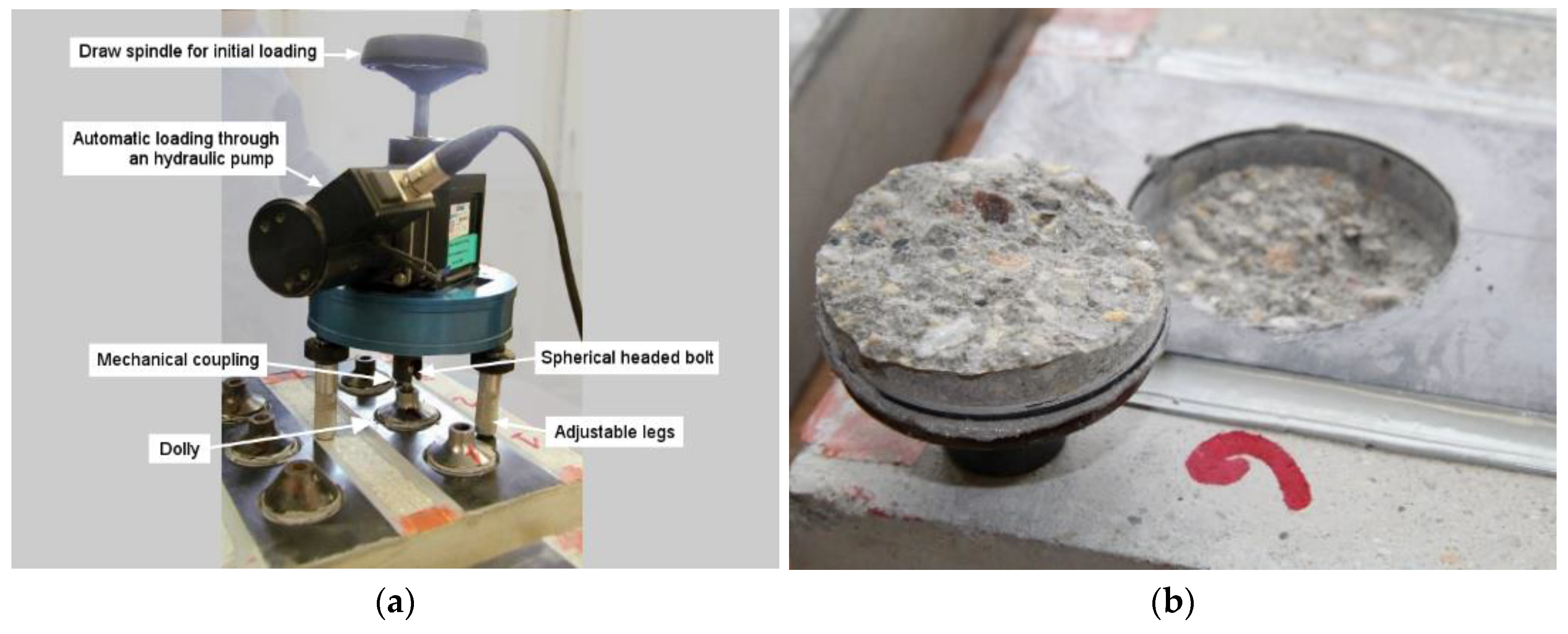

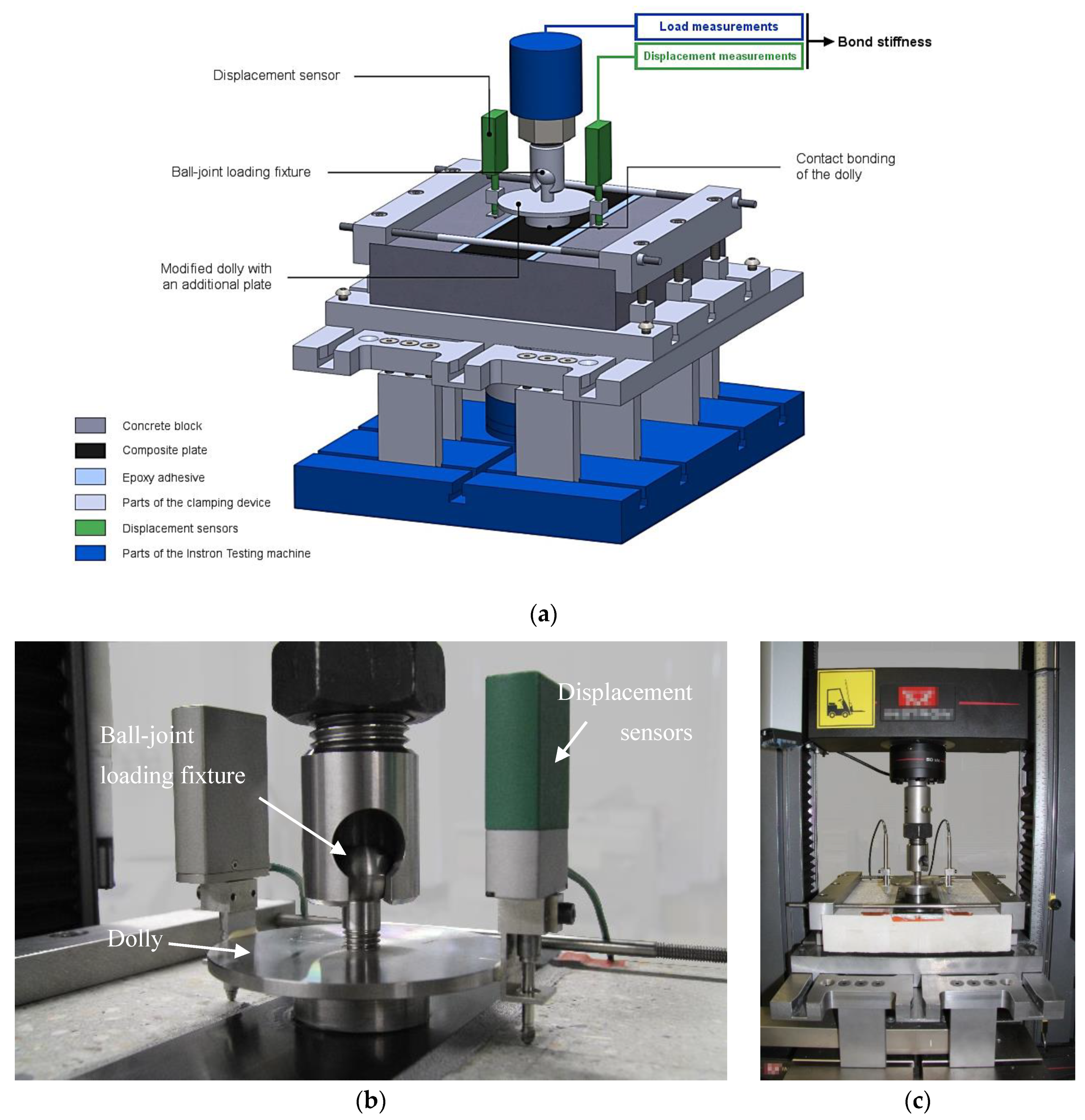
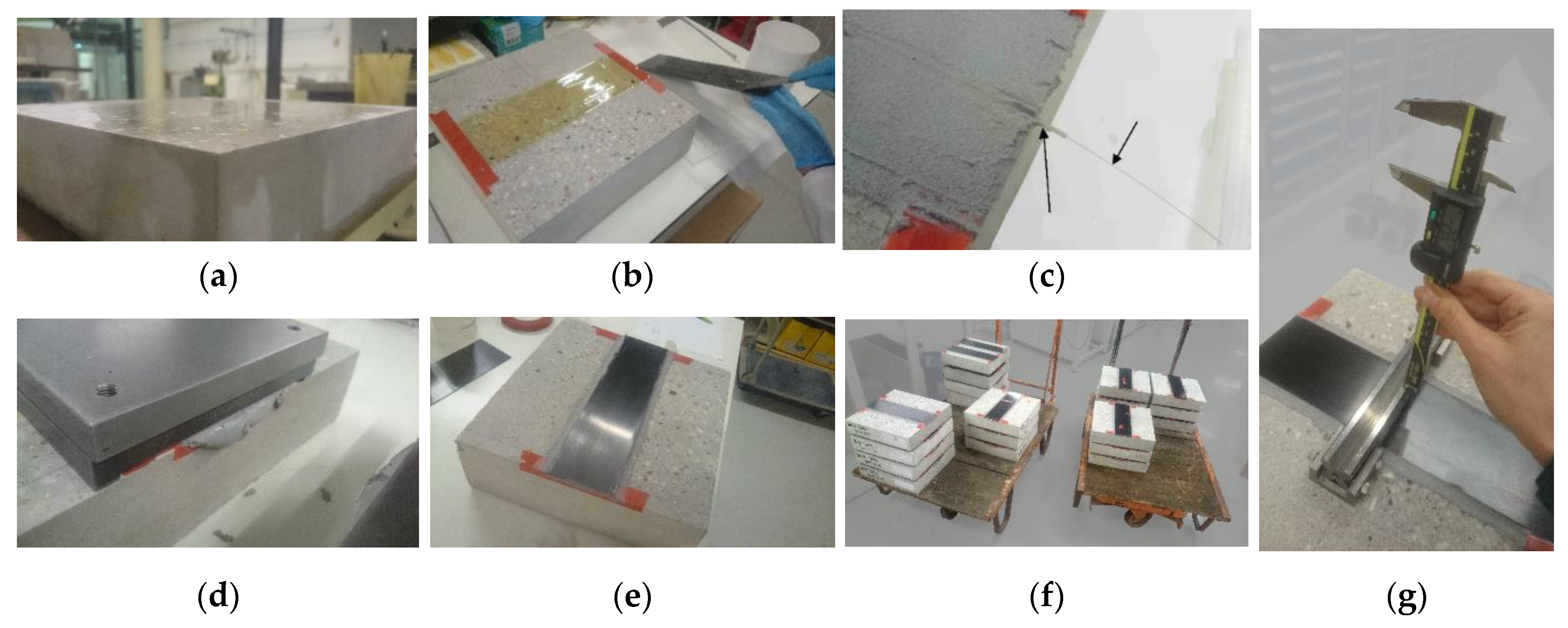
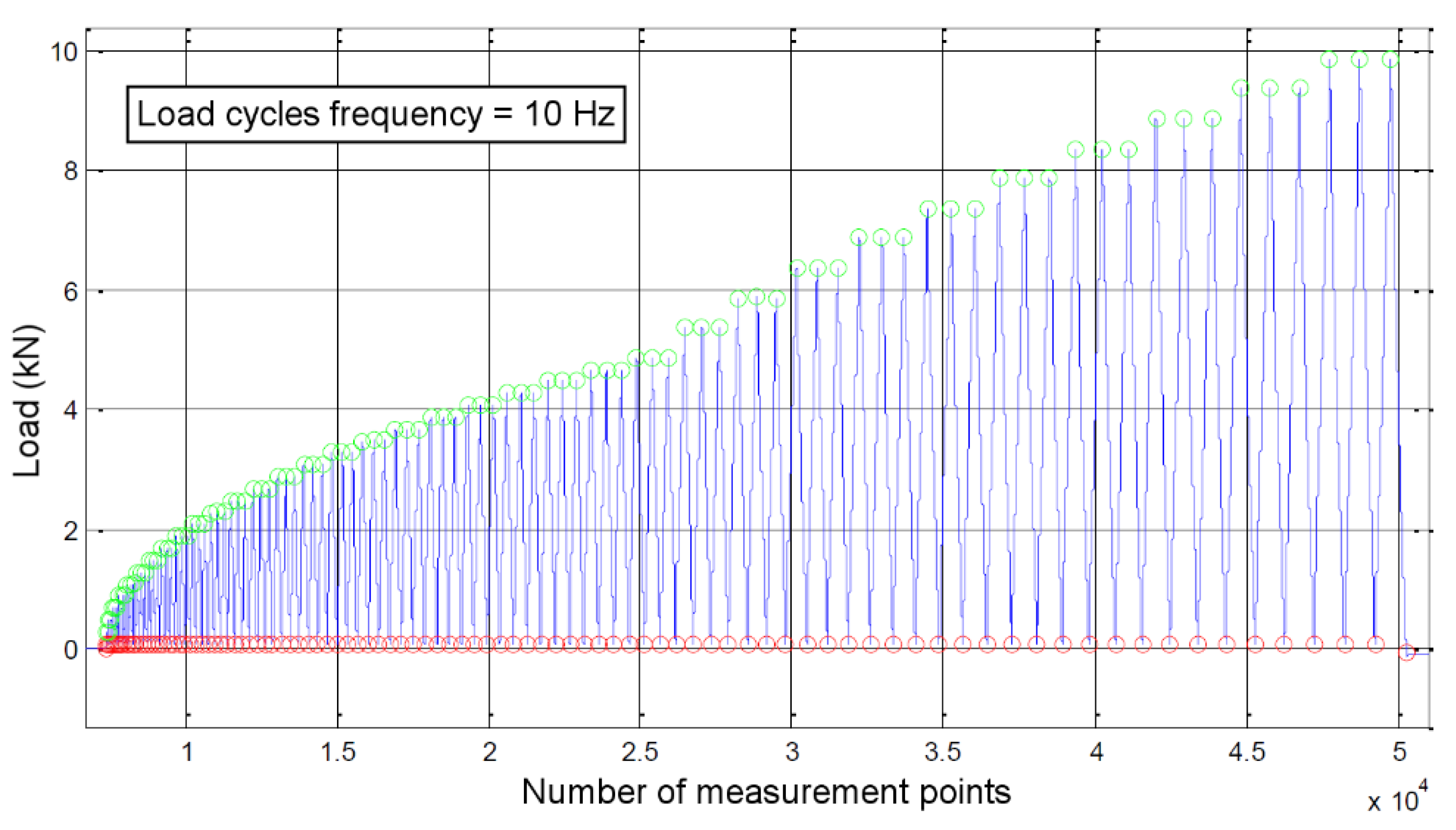
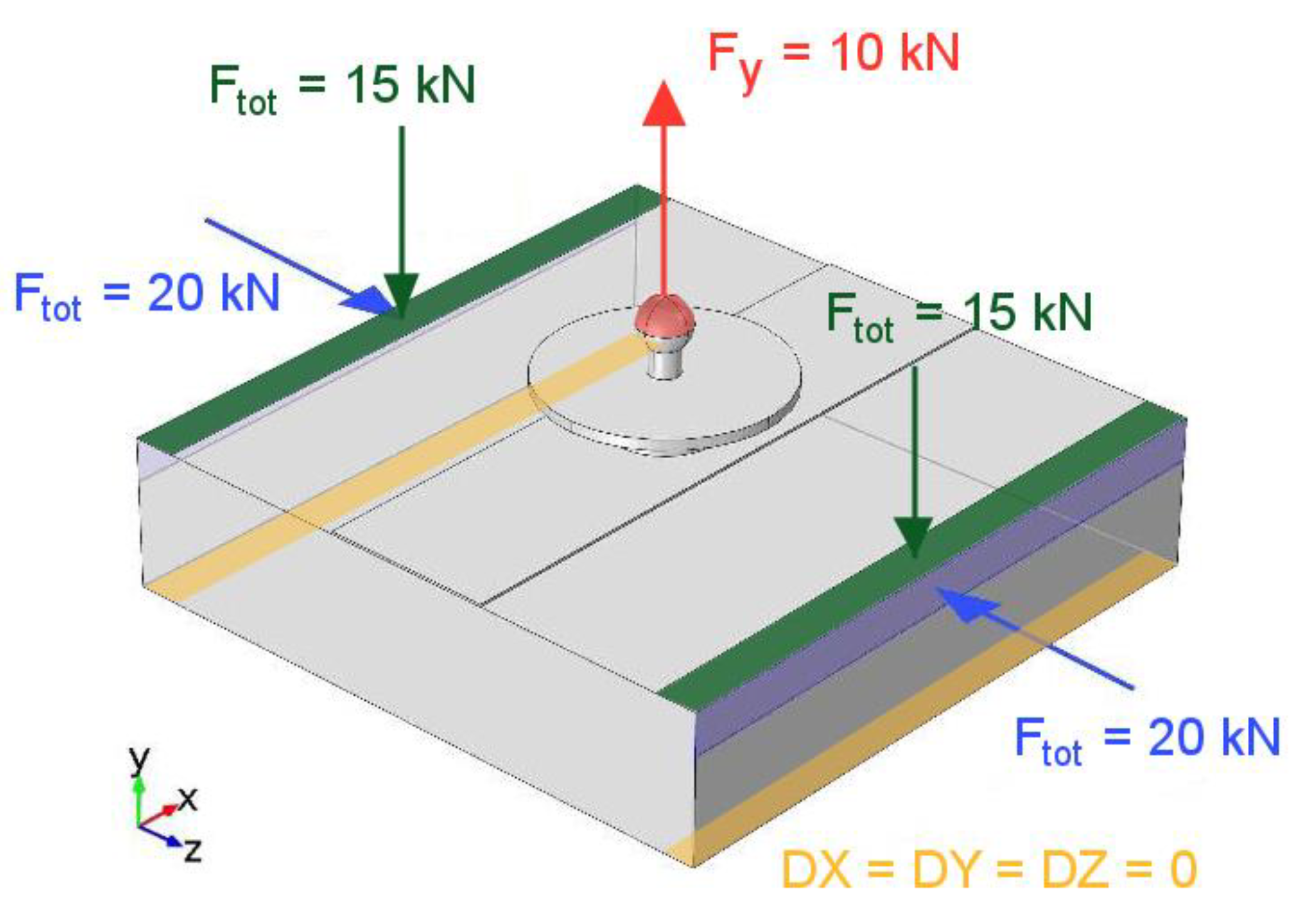
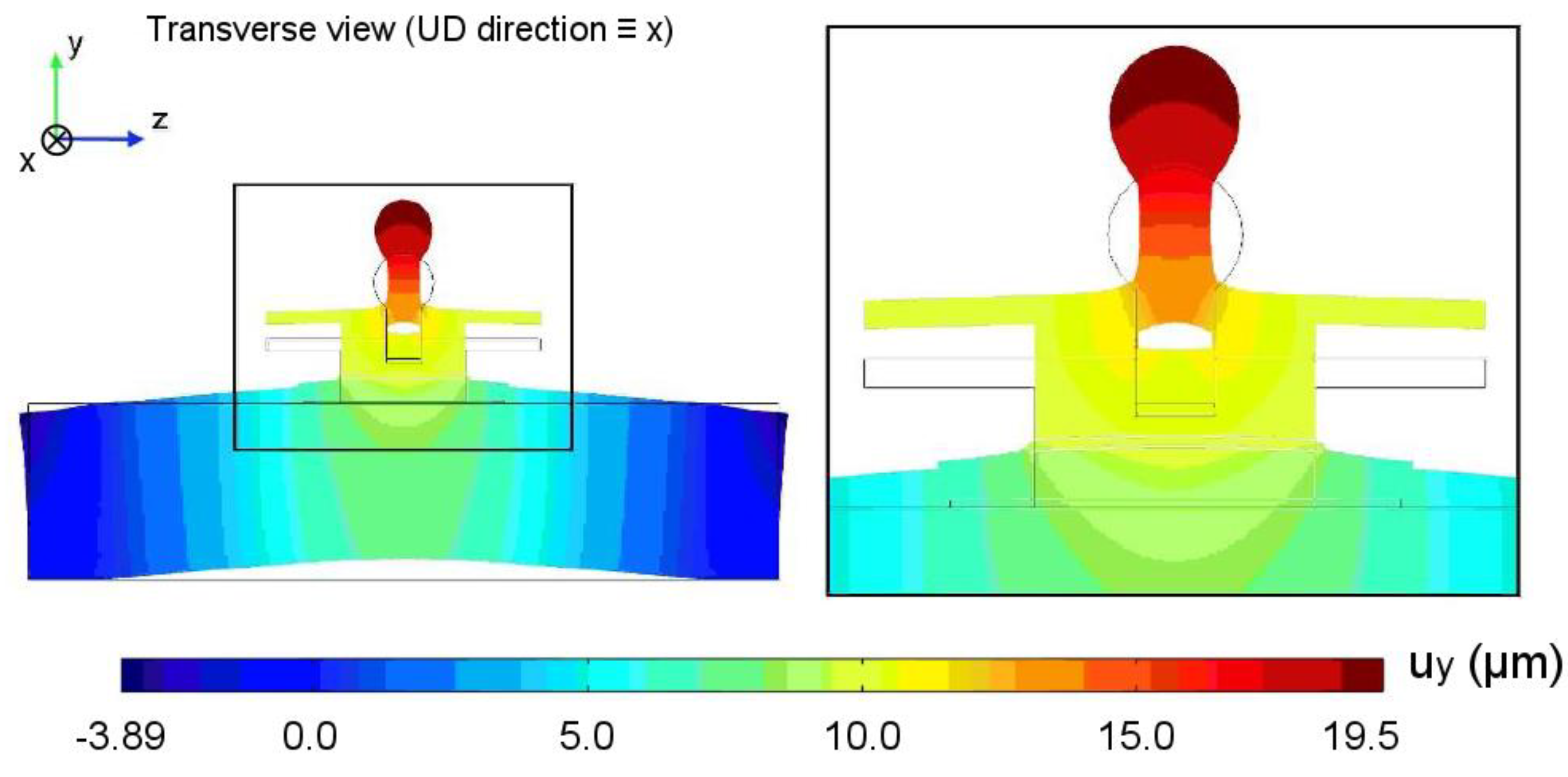
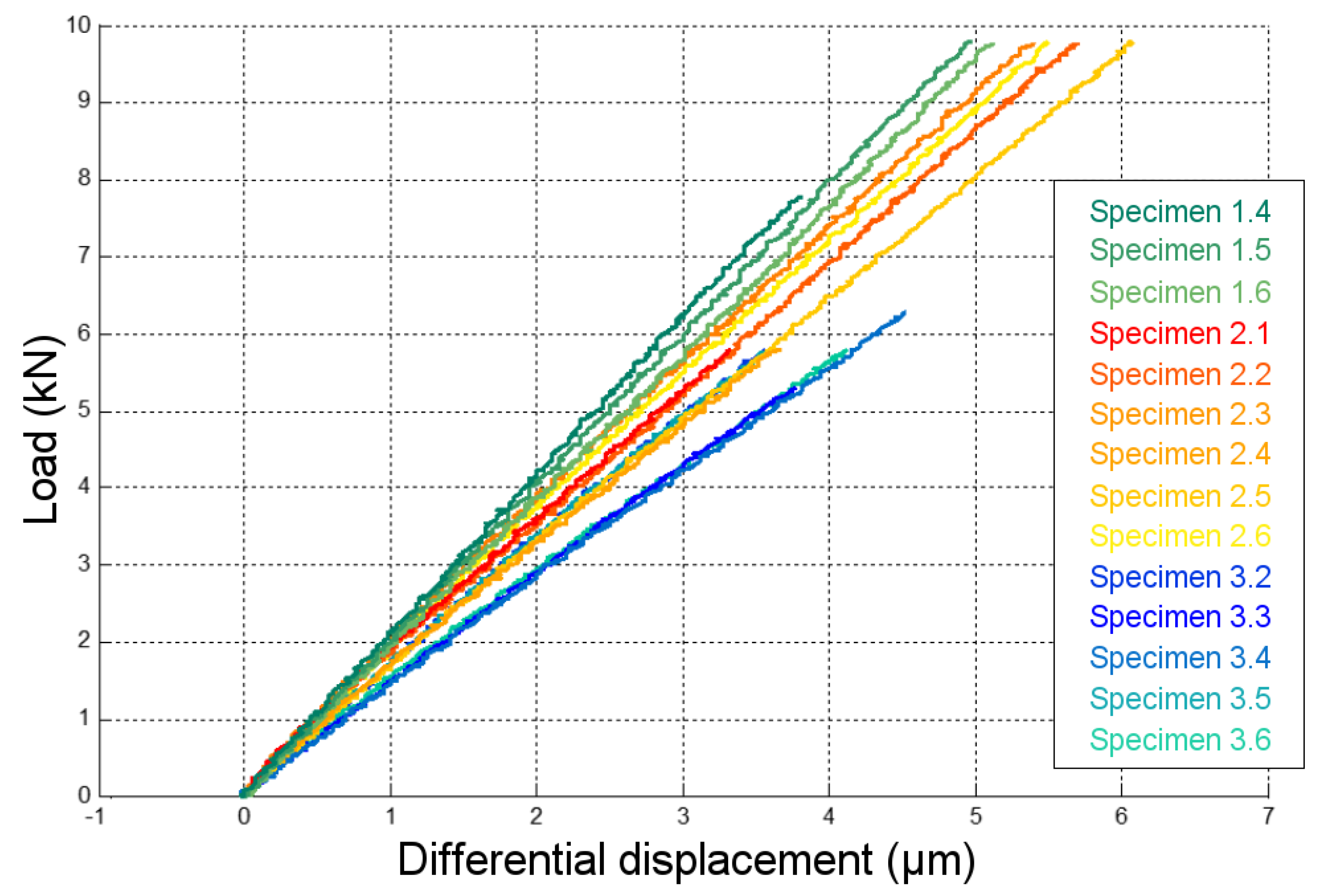
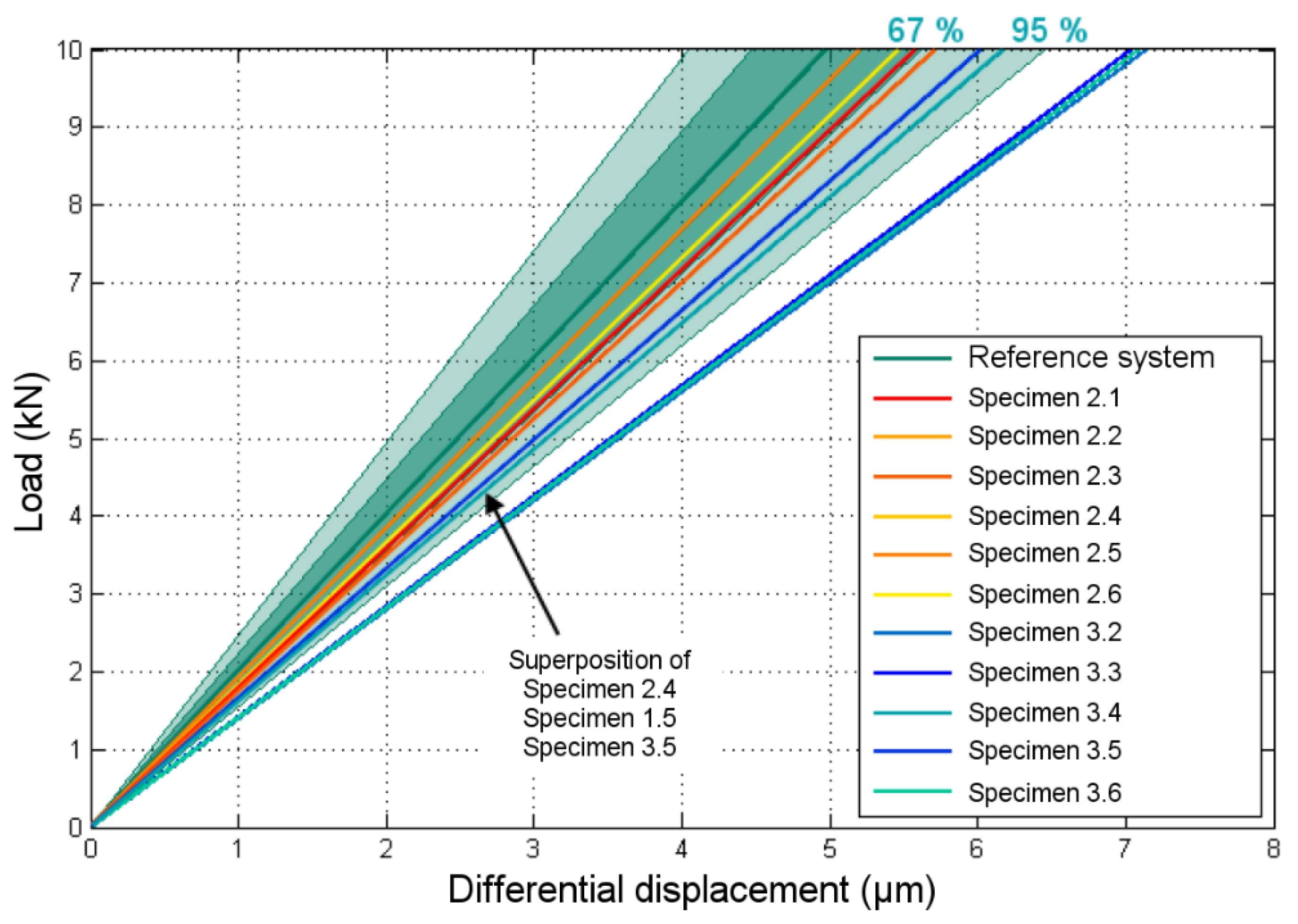

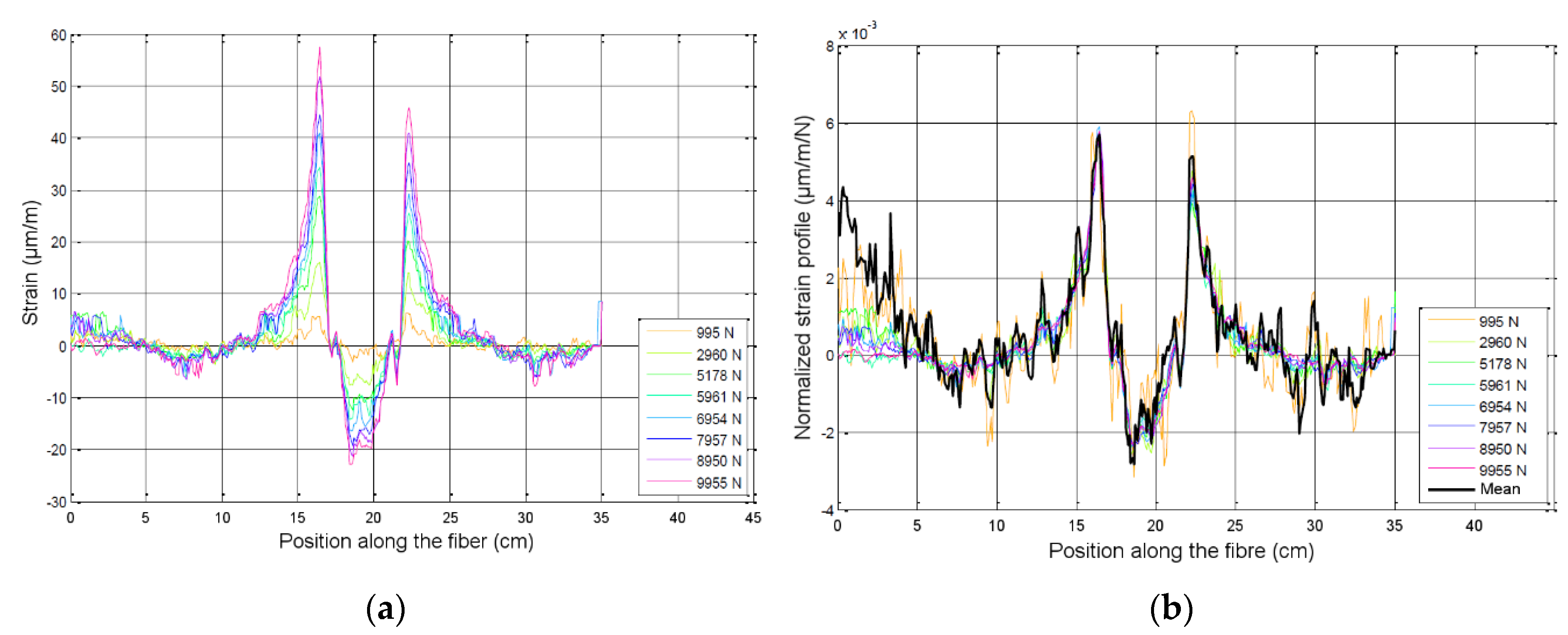
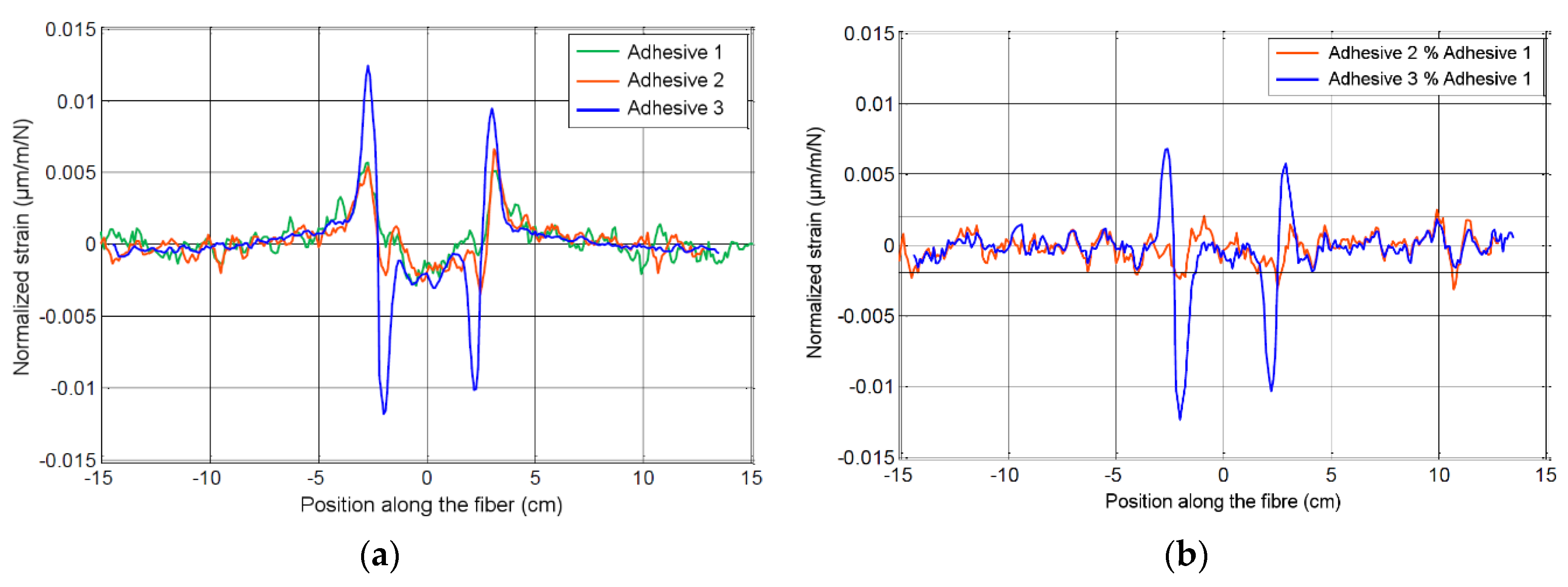
| Description | Thickness | Width | Fiber Content | Tensile Properties (EN 2561) | ||
|---|---|---|---|---|---|---|
| Pultruded unidirectional (0°) CFRP plate | 1.2 mm | 80 mm | >68% | Modulus: 165,000 MPa | Tensile strength: 2900 MPa | Strain at failure: >1.80% |
| Specimen ID | Adhesive 1 | Adhesive 2 | Adhesive 3 | |||||||||||
|---|---|---|---|---|---|---|---|---|---|---|---|---|---|---|
| 1.4 | 1.5 | 1.6 | 2.1 | 2.2 | 2.3 | 2.4 | 2.5 | 2.6 | 3.2 | 3.3 | 3.4 | 3.5 | 3.6 | |
| Displacement Data | 🗸 | 🗸 | 🗸 | 🗸 | 🗸 | 🗸 | 🗸 | 🗸 | 🗸 | × | 🗸 | 🗸 | 🗸 | 🗸 |
| OF Strain Measurement | × | 🗸 | × | × | × | × | × | × | 🗸 | × | × | × | × | 🗸 |
| Specimen ID | Adhesive 1 | Adhesive 2 | Adhesive 3 | |||||||||||
|---|---|---|---|---|---|---|---|---|---|---|---|---|---|---|
| 1.4 | 1.5 | 1.6 | 2.1 | 2.2 | 2.3 | 2.4 | 2.5 | 2.6 | 3.2 | 3.3 | 3.4 | 3.5 | 3.6 | |
| Bond stiffness (×109 N/m) | 2.04 | 1.99 | 1.94 | 1.79 | 1.62 | 1.75 | 1.62 | 1.92 | 1.83 | 1.40 | 1.42 | 1.62 | 1.66 | 1.41 |
| Mean (×109 N/m) | 1.99 | 1.76 | 1.50 | |||||||||||
| Standard deviation (×109 N/m) | 0.03 | 0.12 | 0.13 | |||||||||||
| Sensitive Parameter | Mean | Standard Deviation | Measurement Method | |
|---|---|---|---|---|
| Econcrete | 62 GPa | 7 GPa | Ultrasonic measurement of the dynamical E-modulus | |
| hconcrete | 67.6 mm | 1.7 mm | Ruler | |
| kN,dolly-comp | 2.0 × 1013 Pa/m | 1.0 × 1013 Pa/m | None (arbitrary values) | |
| kN,adh = Eadh/hadh | Adhesive 1 | 1.61 × 1013 Pa/m | 0.7 × 1013 Pa/m | Measurement of hadh with a caliper * (see Figure 4g) Measurement of Eadh by direct tensile tests on bulk adhesive coupons |
| Adhesive 2 | 0.57 × 1013 Pa/m | 0.11 × 1013 Pa/m | ||
| Adhesive 3 | 0.17 × 1013 Pa/m | 0.07 × 1013 Pa/m | ||
| Specimen ID | Adhesive 1 | Adhesive 2 | Adhesive 3 | |||||||||||
|---|---|---|---|---|---|---|---|---|---|---|---|---|---|---|
| 1.4 | 1.5 | 1.6 | 2.1 | 2.2 | 2.3 | 2.4 | 2.5 | 2.6 | 3.2 | 3.3 | 3.4 | 3.5 | 3.6 | |
| Felas (kN) | 8 | 12 | 14 | 6 | 10 | 12 | 7 | 12 | 10 | 10 | 10 | 6 | 10 | 10 |
| Fult (kN) | 13.4 | 13.8 | 16.1 | 10 | 12 | 14.2 | 10 | 16 | 13.3 | 12 | 14 | 10 | 14 | 14.2 |
| Limit load (kN) | 10 kN | 8 kN | 8 kN | |||||||||||
Publisher’s Note: MDPI stays neutral with regard to jurisdictional claims in published maps and institutional affiliations. |
© 2020 by the authors. Licensee MDPI, Basel, Switzerland. This article is an open access article distributed under the terms and conditions of the Creative Commons Attribution (CC BY) license (http://creativecommons.org/licenses/by/4.0/).
Share and Cite
Billon-Filiot, A.; Taillade, F.; Quiertant, M.; Hénault, J.-M.; Renaud, J.-C.; Maurin, R.; Benzarti, K. Development of an Innovative Non-Destructive and Field-Oriented Method to Quantify the Bond Quality of Composite Strengthening Systems on Concrete Structures. Materials 2020, 13, 5421. https://doi.org/10.3390/ma13235421
Billon-Filiot A, Taillade F, Quiertant M, Hénault J-M, Renaud J-C, Maurin R, Benzarti K. Development of an Innovative Non-Destructive and Field-Oriented Method to Quantify the Bond Quality of Composite Strengthening Systems on Concrete Structures. Materials. 2020; 13(23):5421. https://doi.org/10.3390/ma13235421
Chicago/Turabian StyleBillon-Filiot, Astrid, Frédéric Taillade, Marc Quiertant, Jean-Marie Hénault, Jean-Claude Renaud, Romain Maurin, and Karim Benzarti. 2020. "Development of an Innovative Non-Destructive and Field-Oriented Method to Quantify the Bond Quality of Composite Strengthening Systems on Concrete Structures" Materials 13, no. 23: 5421. https://doi.org/10.3390/ma13235421
APA StyleBillon-Filiot, A., Taillade, F., Quiertant, M., Hénault, J.-M., Renaud, J.-C., Maurin, R., & Benzarti, K. (2020). Development of an Innovative Non-Destructive and Field-Oriented Method to Quantify the Bond Quality of Composite Strengthening Systems on Concrete Structures. Materials, 13(23), 5421. https://doi.org/10.3390/ma13235421








